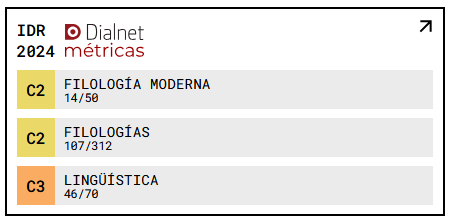Paul Auster’s Transcendentalism: Shifting Postmodern Sensibility in the New Millennium
DOI:
https://doi.org/10.18172/jes.4750Keywords:
Paul Auster, transcendentalism, Ludwig Wittgenstein, language games, Postmodernism, American fictionAbstract
This article traces Paul Auster’s shift in sensibility after the 2001 attacks on the World Trade Center. While his earlier novels where paradigmatic of postmodern self-referentiality, several critics have argued that his post-9/11 production turned towards realism. This might be interpreted as subsidiary evidence in favor of the polemic debate around the death of postmodernism. However, the aim of this article is to outline the transformation of the writer and offer explanations as to why that change in sensibility does not respond to a divestiture of postmodernism, but to an intensification of it. I trace Auster’s alternative to postmodern relativism, that is, transcendentalism, to arrive at the conclusion that his stance towards it is the same in his later novels.
Downloads
References
Auster, P. 1987. In the Country of Last Things. London: Faber & Faber.
Auster, P. 1989. Moon Palace. London: Faber & Faber.
Auster, P. 1992. Leviathan. London: Faber & Faber.
Auster, P. 1994. Mr. Vertigo. London: Faber & Faber.
Auster, P. 2002. “The City and the Country”. The New York Times, 9 Sept. www.nytimes.com/2002/09/09/opinion/09AUST.html (Accessed 13 March 2020).
Auster, P. 2003 (2002). The Book of Illusions. New York, NY: Picador.
Auster, P. 2004 (2003). Oracle Night. London: Faber & Faber.
Auster, P. 2005. The Brooklyn Follies. London: Faber & Faber.
Auster, P. 2007. Travels in the Scriptorium. London: Faber & Faber.
Auster, P. 2008 (1987). The New York Trilogy. London: Faber & Faber.
Auster, P. 2009a. Invisible. London: Faber & Faber.
Auster, P. 2009b (2008). Man in the Dark. London: Faber & Faber.
Auster, P. 2011 (2010). Sunset Park. London: Faber & Faber.
Auster, P. 2012. Winter Journal. London: Faber & Faber.
Bell, I. Introduction. 2000. The American Mystery: American Literature from Emerson to DeLillo. Ed. T. Tanner. Cambridge: Cambridge UP. xiv-xxiv.
Berlin, I. 2013 (1999). The Roots of Romanticism. Princeton, NJ: Princeton UP.
Bloom, H., ed. 2004. Paul Auster. Philadelphia, PA: Chelsea House.
Boxall, P. 2013. Twenty-First-Century Fiction: A Critical Introduction. Cambridge: Cambridge UP.
Burns, C. 2013. “Off the Page: Paul Auster”. Conversations with Paul Auster. Ed. J. M. Hutchisson, Jackson, MS: UP of Mississippi. 125-131.
Ciocia, S. and J. A. González, eds. 2011. The Invention of Illusions: International Perspectives on Paul Auster. Newcastle upon Tyne: Cambridge Scholars.
Emerson, R. W. 1998a (1836). Nature. In The Norton Anthology of American Literature, vol. 1. Eds. N. Baim et al. New York, NY: Norton. 1073-1101.
Emerson, R. W. 1998b (1837). “The American Scholar”. The Norton Anthology of American Literature, vol. 1. Eds. N. Baim et al. New York, NY: Norton. 1101-1114.
Emerson, R. W. 2000 (1844). “Politics”. The Essential Writings of Ralph Waldo Emerson. Ed. B. Atkinson. New York, NY: Random House. 378-389.
Ford, M. 1999. “Inventions of Solitude: Thoreau and Auster”. Journal of American Studies 33 (2): 201-219.
Habermas, J. 1981. “Modernity versus Postmodernity”. New German Critique 22: 3-14. Trans. Seyla Ben-Habib.
Hassan, I. 2003. “Beyond Postmodernism: Toward an Aesthetic of Trust.” Beyond Postmodernism: Reassessments in Literature, Theory, and Culture. Ed. K. Stierstorfer. New York: Walter de Gruyter. 199-212.
Hawthorne, N. 1998a (1843). “The Birth-Mark”. The Norton Anthology of American Literature, vol. 1. Eds. N. Baim et al. New York: Norton. 1261-1273.
Hawthorne, N. 1998b (1843). “The Celestial Railroad”. The Norton Anthology of American Literature, vol. 1. Eds. N. Baim et al. New York: Norton. 1273-1285.
Huber, I. 2014. Literature after Postmodernism: Reconstructive Fantasies. Basingstoke: Palgrave Macmillan.
Hutcheon, L. 2002. “Postmodern Afterthoughts.” Wascana Review 37 (1): 5-12.
Kafka, F. 2008 (1927). Amerika. New York: Schocken Books. Trans. Mark Harman.
Lawson, M. 2010. “Sunset Park by Paul Auster—Review”. The Guardian, 6 November. www.theguardian.com/books/2010/nov/06/paul-auster-sunset-park-review (Accessed 10 December 2020).
Mallia, J. 2013. “Interview with Paul Auster”. Conversations with Paul Auster. Ed. J. M. Hutchisson. Jackson, MS: University Press of Mississippi. 5-12.
McCaffery, L. and S. Gregory. 2013. “An Interview with Paul Auster”. Conversations with Paul Auster. Ed. J. M. Hutchisson. Jackson, MS: University Press of Mississippi. 13-39.
Morris, M. 2013. “A Conversation with Paul Auster”. Conversations with Paul Auster. Ed. J. M. Hutchisson. Jackson, MS: University Press of Mississippi. 163-178.
Šesnić, J. 2014. “Franz Kafka, Paul Auster and the End of the American Century”. Facing the Crises: Anglophone Literature in the Postmodern World. Eds. L. Matek and J. P. Rehlicki. Newcastle upon Tyne: Cambridge Scholars. 49-69.
Simonetti, P. 2011. “Loss, Ruins, War: Paul Auster’s Response to 9/11 and the ‘War on Terror’”. The Invention of Illusions: International Perspectives on Paul Auster. Eds. S. Ciocia and J. Ángel González. Newcastle upon Tyne: Cambridge Scholars. 13-38.
Thoreau, H. D. 1998 (1849). “Resistance to Civil Government”. The Norton Anthology of American Literature, vol. 1. Eds. N. Baim et al. New York: Norton. 1752-1767.
Veisland, J. 2015. “The Artist’s Hand: The Aesthetics of Loss in Paul Auster’s Sunset Park”. Forum for World Literature Studies 7 (2): 312-327.
Wolfe, T. 1989. “Stalking the Billion-Footed Beast: A Literary Manifesto for the New Social Novel”. Harper’s Magazine 279: 45-56.
Wood, M. 2013. “The Art of Fiction”. Conversations with Paul Auster. Ed. J. M. Hutchisson. Jackson, MS: University Press of Mississippi. 132-148.
Downloads
Published
How to Cite
Issue
Section
License
The authors retain copyright of articles and authorize Journal of English Studies the first publication. They are free to share, redistribute, and/or reprint the article without obtaining permission from the publisher as long as they give appropriate credit to the editor and the journal.
Self-archiving is allowed too. In fact, it is recommendable to deposit a PDF version of the paper in academic and/or institutional repositories.
It is recommended to include the DOI number.
This journal is licensed under a Creative Commons Attribution 4.0 International License













